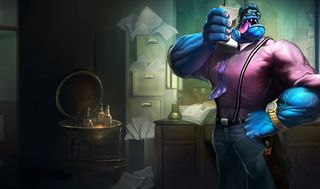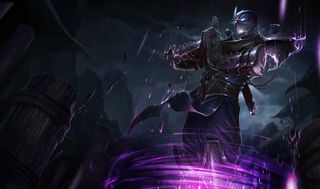Closing the deal in League of Legends

Ideally, when a team is 10 kills ahead, controls all of the Dragon buffs so far, and has a significant gold and item lead, it shouldn't take nearly an hour to actually close out the game. And yet, as was demonstrated by Cloud 9 Tempest during the most recent North American Challenger Series matches, teams are still working on bridging that rather wide gulf between ideal and execution.
It's maybe unfair to scapegoat Henrik Hansen for this, but the inability to close out when ahead is something I'd very much like to call the Froggen Fallacy. Sure, teams in every region are susceptible to it—ahq E-Sports Club back in 2014 had some of the grindiest games imaginable regardless of how well they did in the early phases, as did NaJin White Shield. But nobody exemplifies cautious low-risk play styles more than Europe's most storied mid laner, and so there are few others that deserve to be blamed for the copycats in the wake of his prior-year successes.
What many don't seem to understand is that Froggen's stylistic quirks were the results of his successes back in the 2012 metagame, when the period's sustained damage scaling (such as from AD carries) and kiting capabilities (ahem, Anivia) were strong determinants to game outcome. It isn't, inherently, optimal play—especially not in the face of literal years of changes both inside and outside of the game. Drafting a better-scaling team composition won't mean much if your team's understanding of power dynamics and objectives control remains two years out of date.
So let's update ourselves on what it actually takes to win a game these days.
Rise and fall
Obviously, to win the game, you have to take the nexus. Between you and it, however, are a minimum of five towers and one inhibitor, all of which are jealously guarded, and more besides if you can't find a way to simply plow your way through one lane. You can, of course, just rally everybody up and throw bodies at a turret until it crumples—except that the turret itself will probably kill most of your team in the process, or by the time you finish one or two turrets you'll find that the other team's somehow gotten a significant gold and level advantage on you.
The Red Queen's Race for gold and experience is the main detriment to 0-minute rush strategies. The advantages garnered from conventional farming largely outweighs that of early turrets—less so now than in previous years, but the game's nonetheless balanced to encourage you to spend time in lane equal to the time your opponent does. First to flinch starts to inexorably fall behind.
But there are exceptions and loopholes to that Race. Not all champions have the same strong points, fulfill the same roles, or build the same set of items. So not all champions get as much out of reaping minions like a combine in a mid-August wheat field. Thus the concepts of "power spikes" and "power troughs" regularly used when describing professional play—a good team knows when to take advantage of a comparative power advantage, swiftly ending the laning phase at that point to push for map control (or, conversely, lengthening it with stall tactics to diffuse the other team's advantages).
The biggest gaming news, reviews and hardware deals
Keep up to date with the most important stories and the best deals, as picked by the PC Gamer team.
Early power spikes largely center on whomever finishes Trinity Force first. Paradoxically, even, as the item's 3703 gold value makes it among the most expensive completed items in the game. But in exchange for its steep asking price, the power advantage conferred by the item is immediately accessible, and is often enough the only offensive item needed by a champion throughout a game.
In comparison, AD carries that build Infinity Edge instead often find themselves playing a passive start. They're stuck in a power trough instead, as though the item gives a lot of raw AD and critical hit potential, the lack of attack speed or self-triggered damage bonuses makes it scale up less immediately.
It should go without saying, but that's exactly when you need to shove in. Passive play during power spikes is potential squandered. A team that durdles when they should be on the march is a team asking to be outscaled.
Of course, there's such thing as over-reaching. Teams probably shouldn't be going for multiple Tear of the Goddess builds among their carries in the first place, as China's Edward Gaming demonstrated against LGD. The sprawling multi-minute combat sequences between the heavy-hitting Mainland teams was biased in favor of LGD despite EDG's advantageous ganks early on. Both Cassiopeia and Urgot would've become late game monsters, but their head-to-head fight right smack in the middle of the map at 22 minutes was way too early compared to the power spike of a Blade of the Ruined King Kalista and a Rod of Ages Ryze in the same time frame.
Setting the bait
Forcing your win conditions along power spikes is easy enough to understand, but it does get subsequently harder the more turrets you take down. League of Legends—and, indeed, most MOBAs—have an inherent snapback mechanic built into its map design: the losing team will find it easier to return to and defend their remaining objectives. While there's a limit to this (the longer a game goes, the longer it takes to respawn back into the fight), the shortened distance to base and shrinking approach options helps strategies such as the aforementioned dual-Tear compositions to feasibly pull back into the game, given sufficient mental fortitude and grit.
But that's also no excuse for the passive play we see from so many teams. In fact, it's the exact opposite. There are two primary ways to break through the siege, and the caliber of a team can often be determined by how well they do either.
The first and probably easiest to execute is to simply force them to fight. Baron Nashor and Dragon buffs are especially good ways to do so: the statistical boost they provide often allows a team to forgo all caution and just run straight at the turrets. And as such, you don't even need the buffs. Instead of fighting with an actively enraged Baron Nashor spitting bile and acid on both sides, the threat of it alone ought to be enough to lure the defending team off turrets and into ambushes. Given that there are only three viable routes to Baron from any one side in the first place, the ambush strategy requires strong understanding of vision control and timing to execute—but can often end the game right there and then.
Of course, not all compositions necessarily favor that strategy. If the defending team's full of area-of-effect crowd control and nukes, a jungle fight even with a gold and item advantage can go horrendously wrong. And this is where splitpushing comes into play. A poke composition, reliant on Jayce and Corki to spit missiles out from outside engagement range, isn't going to win down'n'dirty fights in the jungle. But they are great at forcing teams to stay under a single turret, the threat of their quick turret demolition sealing off maneuvering options for the enemy team. That buys them time for a split pusher to move to an undefended lane and put down damage.

That leads us to one of the most underrated items in the game: Banner of Command. As it shares a build path with Aegis of Legion, it's often overlooked—Locket of the Iron Solari is more immediately useful in fights, thanks to its group shielding and bolstered resistances.
Banner of Command, on the other hand, makes a siege minion immune to magic damage and buffs its own damage output. That makes it an infinitely better map play item, and absolute critical to strategies dependent on cautious siege. Defending teams are forced to either let the turret take the minion, or sacrifice physical damage at a contested turret to defend against the minion. And if it's Shen packing it, that's even better: he can cover his options all on his own, choosing either to tend to the splitpush and keep the minion alive, or take advantage of the alleviated pressure on the siege lane to join his team and crush the opposition.
What you don't do, in this metagame, is simply wait around for the opponent to make a mistake. That, in itself, is a mistake—one that the opposing team can now use against you. In the words of salespeople everywhere: always be closing.
Most Popular

